


Source: Kids News
The first gold rush in Australia began in May 1851 after prospector Edward Hargraves claimed to have discovered payable gold near Orange, at a site he called Ophir. Before the end of the year, the gold rush had spread to many other parts of the state where gold had been found, not just to the west but also to the south and north of Sydney.
The Australian gold rushes changed the convict colonies into more progressive cities with the influx of free immigrants. These hopefuls, termed diggers, brought new skills and professions, contributing to a growing economy. The mateship that evolved between these diggers and their collective resistance to authority led to the emergence of a unique national identity. Although not all diggers found riches on the goldfields, many decided to stay and integrate into these communities. The influx of wealth into the country completely transformed the country, and for a while, Melbourne, made rich by discoveries of gold in Victoria, would become the world's second largest city, second only to London. Read through the resources below to learn more about this time in Australian history.
Unearth extraordinary stories of people who came to this country to try – but mostly fail – to make their fortune finding gold with this interactive website. What did people eat, wear, do for fun, sing, read, paint and cry about? How did people build homes, make laws, mourn their dead and provide for their families? Read through the resources, including an interactive map of gold rush locations in Australia, to find out more.
The experience of life on the goldfields was different for all who arrived, but few had it easy. Learn about the people and communities who made the gold fields into a vibrant, multicultural and sometimes dangerous place to live with this website.
In Victoria in the 1850s the introduction of a gold license was extremely unpopular. Although many diggers wanted it abolished immediately, the question of the license could not be separated from more complex questions about government revenue and taxation policy. The new Governor, Charles Hotham, was planning to review and reform these areas but he needed time and time was running out. He also felt strongly that existing laws, however unpopular, needed to be strongly enforced. Watch this clip to learn more.
In the 1850s tens of thousands of Chinese people flocked to Victoria, joining people from nations around the world who came here chasing the lure of gold. Fleeing violence, famine and poverty in their homeland Chinese goldseekers sought fortune for their families in the place they called ‘New Gold Mountain’. Chinese gold miners were discriminated against and often shunned by Europeans. Despite this they carved out lives in this strange new land. Read through this website to learn more.
The gold fields were a melting pot of people from all around the world. They spoke different languages and dialects and often chose to live and work with people from their own country: Germans would set up a specific camp, for instance, as would the Irish and the Welsh. In the 1850s Chinese people quickly became the largest national sub-group outside of the British on the goldfields. At the height of Chinese migration to Victoria they made up over one-fifth of the male goldfields population, in some towns more than half the goldseekers resident were Chinese. Read through this website to learn more about life on the gold fields.
Many walked to the diggings, but the Chinese had to walk the furthest. Read through this website to find out more.
From the first few Chinese arrivals on the goldfields in the early 1850s anti-Chinese sentiment swelled. Not all fellow goldseekers were unkind or unwelcoming but many European miners saw the Chinese as alien. Moreover, Chinese mining methods were very efficient, leading the European contingent to fear an 'invasion' of Chinese miners would take too much gold. Read through this website to learn more.
During the nineteenth century, horse-drawn vehicles were an essential part of life in rural Victoria. In Ballarat, local coachbuilding firms assisted with the town’s growth in more ways than providing passage to the diggings. Horse-drawn vehicles were vital for the delivery of goods, responding to emergencies and often symbolised one’s social standing. Read through this article to learn more.
The discovery of gold in the 1850s started a series of rushes that transformed the Australian colonies. The first discoveries of payable gold were at Ophir in New South Wales and then at Ballarat and Bendigo Creek in Victoria. In 1851 gold-seekers from around the world began pouring into the colonies, changing the course of Australian history. The gold rushes greatly expanded Australia’s population, boosted its economy, and led to the emergence of a new national identity. Read through this website to learn more.
One of the biggest gold rushes in history was started in New South Wales, Australia, in 1851. Hundreds of thousands of "diggers" from other parts of Australia, Great Britain, Poland, Germany, and even California sought their fortunes and redefined Australia's national identity. Read through this article to learn more.
The gold rushes and the diggers who worked the goldfields are etched into Australian folklore. Read through this article to learn more.
Read through this website to learn more about some of the interesting people and things from the Australian gold rush.
Victoria is a world-renowned gold province and our history is closely connected to gold mining. Gold discovery at Ballarat in 1851 sparked Victoria's famous gold rush. An estimated 6000 diggers (miners) arrived each week seeking their fortune. Ballarat was considered the world's richest alluvial goldfield during its peak between 1852 and 1853. Our gold rush brought migrants from all over the world to Victoria. Over the space of one year, nearby Bendigo was transformed from a sheep station into a bustling town of 40,000 people. Melbourne earned the nickname 'Marvellous Melbourne', drawing comparisons to Paris and London, due to the huge influx of wealth and migrants. The economic and cultural impact of this mass migration shaped the future of Victoria. Read through this website to learn more.
The Gold Rush had significant impacts on the lives of Aboriginal people. The Mobs on whose Country gold was mined faced huge upheaval as a huge influx of settlers came to their land. Much of their country was destroyed by mining and Mob were further dispossessed from their lands. Read through this website to learn more.
The importance of sketches, paintings and prints as a record of everyday life on the goldfields can’t be understated, particularly as the use of photography was still in its infancy in the 1850s. Read through this article to learn more about the gold rush and how it was depicted in art.
By the early 1850s, news of a gold rush in Australia had reached southern China, sparking an influx in Chinese migration to Australia. Read through this website to learn more about life for Chinese workers on the gold fields.
By the early 1850s, news of a gold rush in Australia had reached southern China, sparking an influx in Chinese migration to Australia. It is thought that approximately 7000 Chinese people came to work at the Araluen gold fields in southern NSW. The Chinese miners often worked in organised groups of 30 to 100 men under the direction of a leader, which resulted in their gold digging efforts being very successful. Conflict between the Chinese and Europeans on the goldfields stemmed from the European miners’ resentment of these successes. This ongoing tension and resentment from the European gold miners came to a head in the Lambing Flat Riots, a series of violent anti-Chinese demonstrations in the Burrangong region of NSW. Read through this website to learn more.
In the early 1850s, many Chinese immigrants came to Australia as indentured labourers working as shepherds, rural labourers, cooks and gardeners. In 1853, the first boatload of Chinese miners arrived in Victoria. Between 1854 and 1855, about 31,000 Chinese people arrived on the Australian goldfields. There was anti-Chinese sentiment, hostility, discrimination and prejudice. Jealousy arose sometimes due to the success of the Chinese miners. There were significant attempts by the European population to restrict Chinese people from entering the colonies. Read through this website to learn more.
Gold was discovered in Australia in 1851 – first in New South Wales and then in Victoria. The effect of the discoveries was electrifying. Here at last was a chance for independence from a life of wage-labour. A chance, with real luck, to make a fortune most could only dream of. All over Australia men downed tools and left for the goldfields. Australia’s first gold rush had begun! Read through this website to learn all about life on the gold fields.
Victoria, previously known as the Port Phillip district, became the colony of Victoria in 1851, the same year gold was discovered. The rich history of the Gold Rush helped to shape the Australia we know today, continuing to exert an influence. Here are 10 things you need to know that occurred through the Gold Rush.
Thanks to the gold rush, Melbourne boomed into a rich and thriving city. Read through the links on this website to learn more about how the wealth of the gold rush impacted Melbourne.
Choose a character and play this game to see if you would make it on the gold fields!


Attributed to Richard Daintree this image is part of the first photographic series of Australian scenes presented for sale to the public. Produced by the studio of Antoine Fauchery and Richard Daintree in 1858, this photograph is one of 53 collectively known as the Fauchery-Daintree Album.
Using the latest collodian wet-plate process, Fauchery and Daintree produced their collection of albumen silver prints at a time when the sales of photographs were flourishing.

Clunes in the Central Highlands was the location of the first offical gold rush in Victoria in 1851. This photo was taken aproximately 10 years later.

Attributed to Richard Daintree this image is part of the first photographic series of Australian scenes presented for sale to the public. Produced by the studio of Antoine Fauchery and Richard Daintree in 1858, this photograph is one of 53 collectively known as the Fauchery-Daintree Album.
Using the latest collodian wet-plate process, Fauchery and Daintree produced their collection of albumen silver prints at a time when the sales of photographs were flourishing.

Attributed to Richard Daintree this image is part of the first photographic series of Australian scenes presented for sale to the public. Produced by the studio of Antoine Fauchery and Richard Daintree in 1858, this photograph is one of 53 collectively known as the Fauchery-Daintree Album.
Using the latest collodian wet-plate process, Fauchery and Daintree produced their collection of albumen silver prints at a time when the sales of photographs were flourishing.

A group of Chinese miners walking to the goldfields with their bundles of belongings.

John Alloo arrived in Australia during the 1840s - before the goldrush began. Proficient in English, he became a successful businessman in Ballarat, operating a restaurant, working as an interpreter and later, migrating to New Zealand where he ultimately rose to the ranks of Police District Constable.
Newspaper clipping, The Australian News, 27 September 1866.
Photograph of a Chinese settlement area in Hepburn, Victoria
Three-piece gold weighing apparatus.
Phrasebook containing common English and Chinese phrases
Unknown maker, Gold rush era
What do you think the choice of phrases here says about about Chinese and European relations?
Photograph of three miners, possibly a Chinese, an African, and European.
Unknown maker, c. 1910
A Drum that was probably used by the Chinese opera performers on the Ballarat goldfields during the Australian gold rush
Unknown maker, c. 1860s
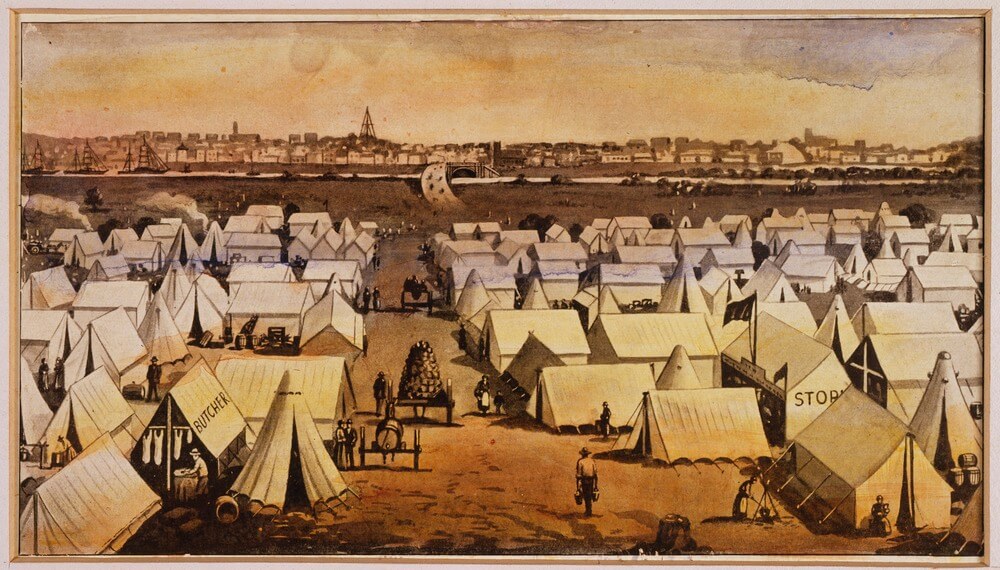
Melbourne’s population in 1851 was 23,000. In just four months in 1852, 619 ships arrived carrying over 55,000 passengers. Accommodating the new arrivals was impossible. Hundreds spent a night or more on the wharves among the barrels and bales. Thousands more went to ‘Canvas Town’, a sprawling tent city on the south bank of the Yarra River.
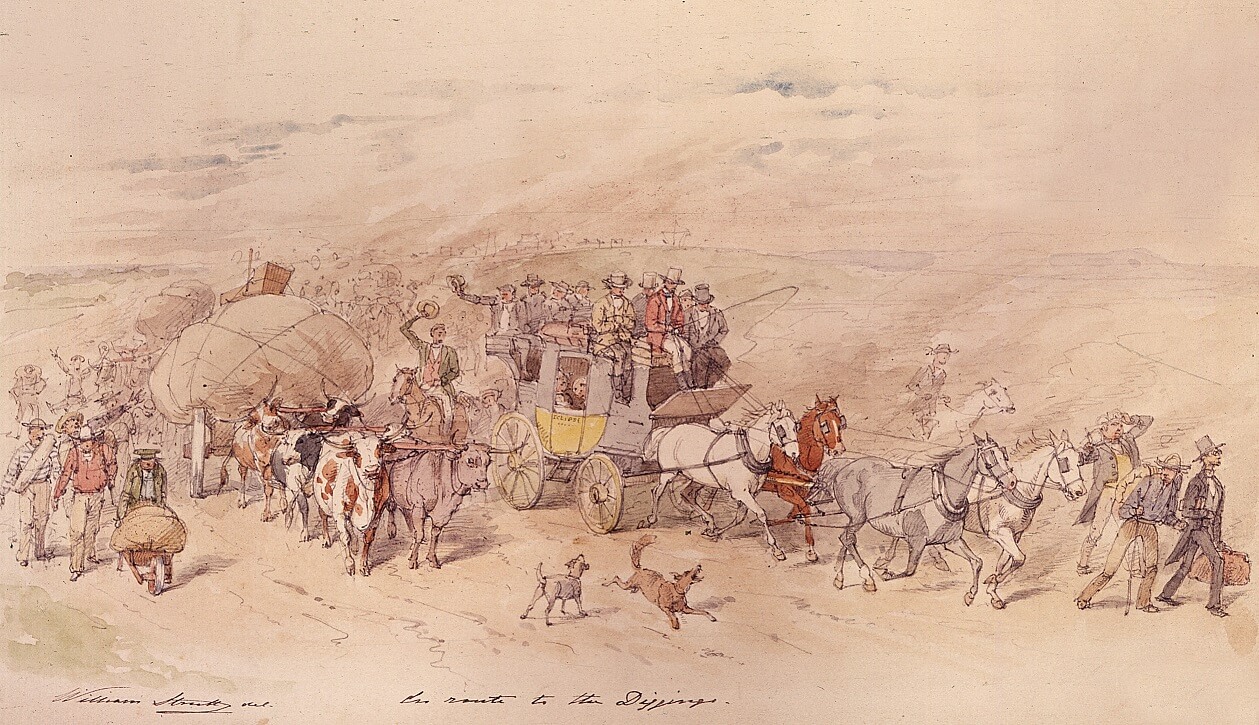
Hopeful diggers set out from Melbourne to the goldfields. Some can afford the coach, with their luggage carried by cart, while others must go on foot.
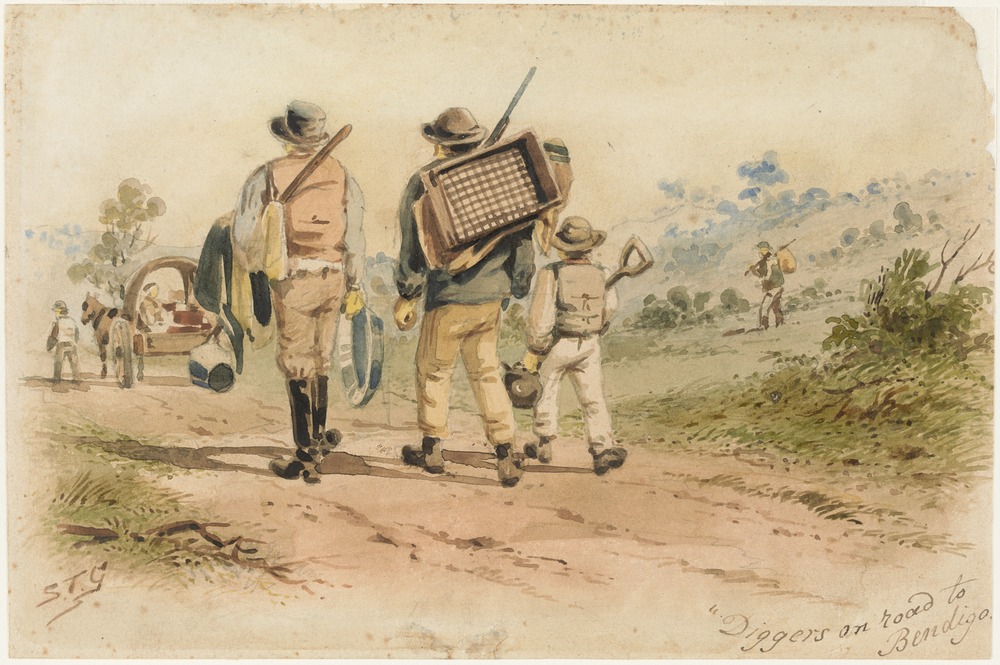
In this painting S. T. Gill captures the essence of the long, dry and dusty trek to the Victorian goldfields. Unusually a child accompanies the diggers.
Of those who went from a port to the goldfields in the early 1850s, most walked the whole way. Loading themselves with a small tent, blankets, pick and shovel and pan, cooking implements and perhaps a little flour and tea, they staggered along the road.
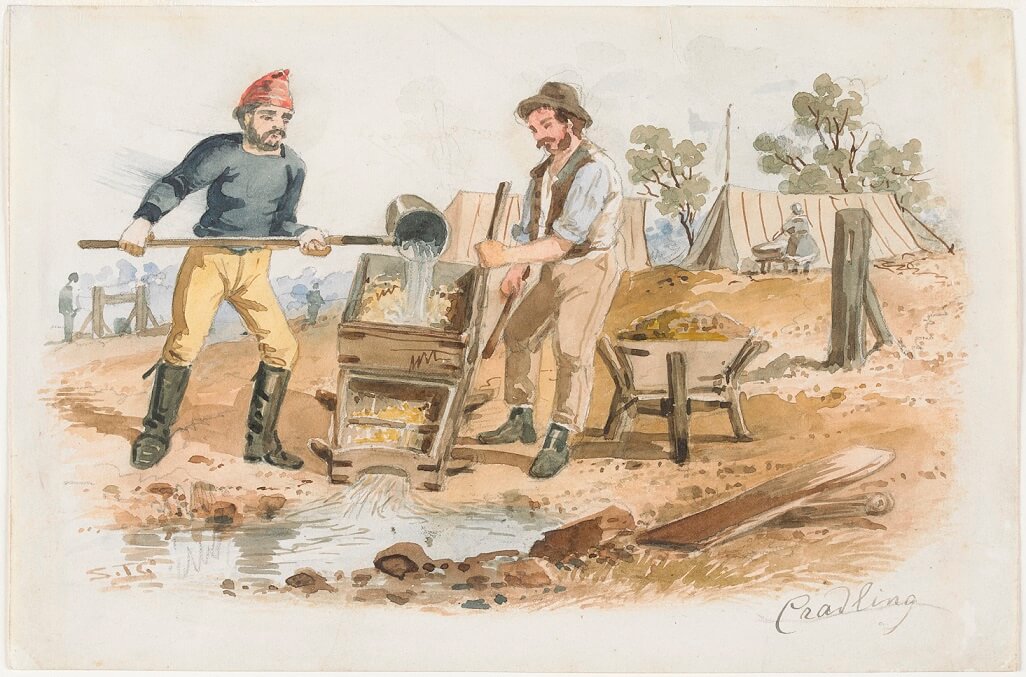
Mining shallow alluvial gold was straightforward. All you needed was a regular water supply, picks and shovels, pans, and a cradle like the one shown here. The top of the cradle was filled with soil and water, then rocked forcing water and soil through the sieve, leaving any gold behind.
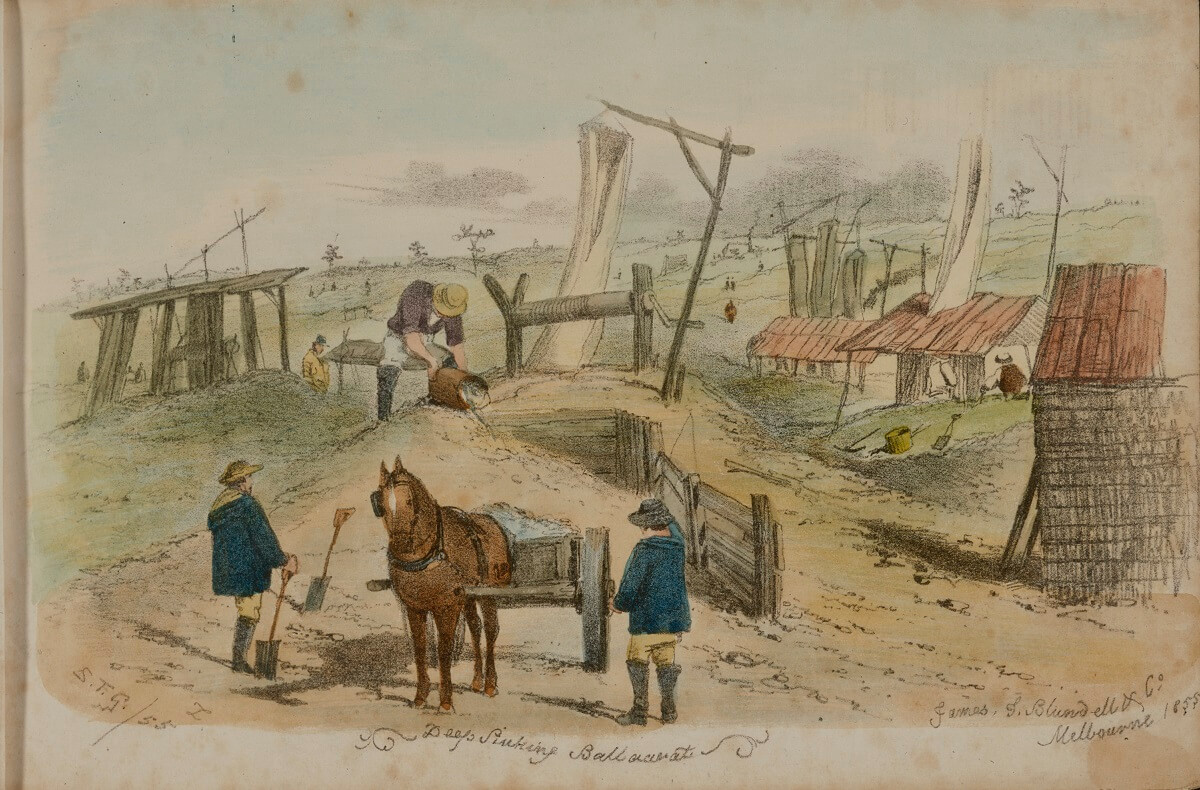
When the surface gold ran out, people dug deeper into the ground. They used hand-operated windlasses with buckets on ropes to bring the dirt and gold to the surface. Eventually, the gold was so deep, and in such hard rock, that expensive heavy machinery including rock drills and crushing batteries were needed. By the 1860s most men on the Victorian fields were working for wages, employed by mining companies. They alone could raise sufficient capital to reach the underground gold.
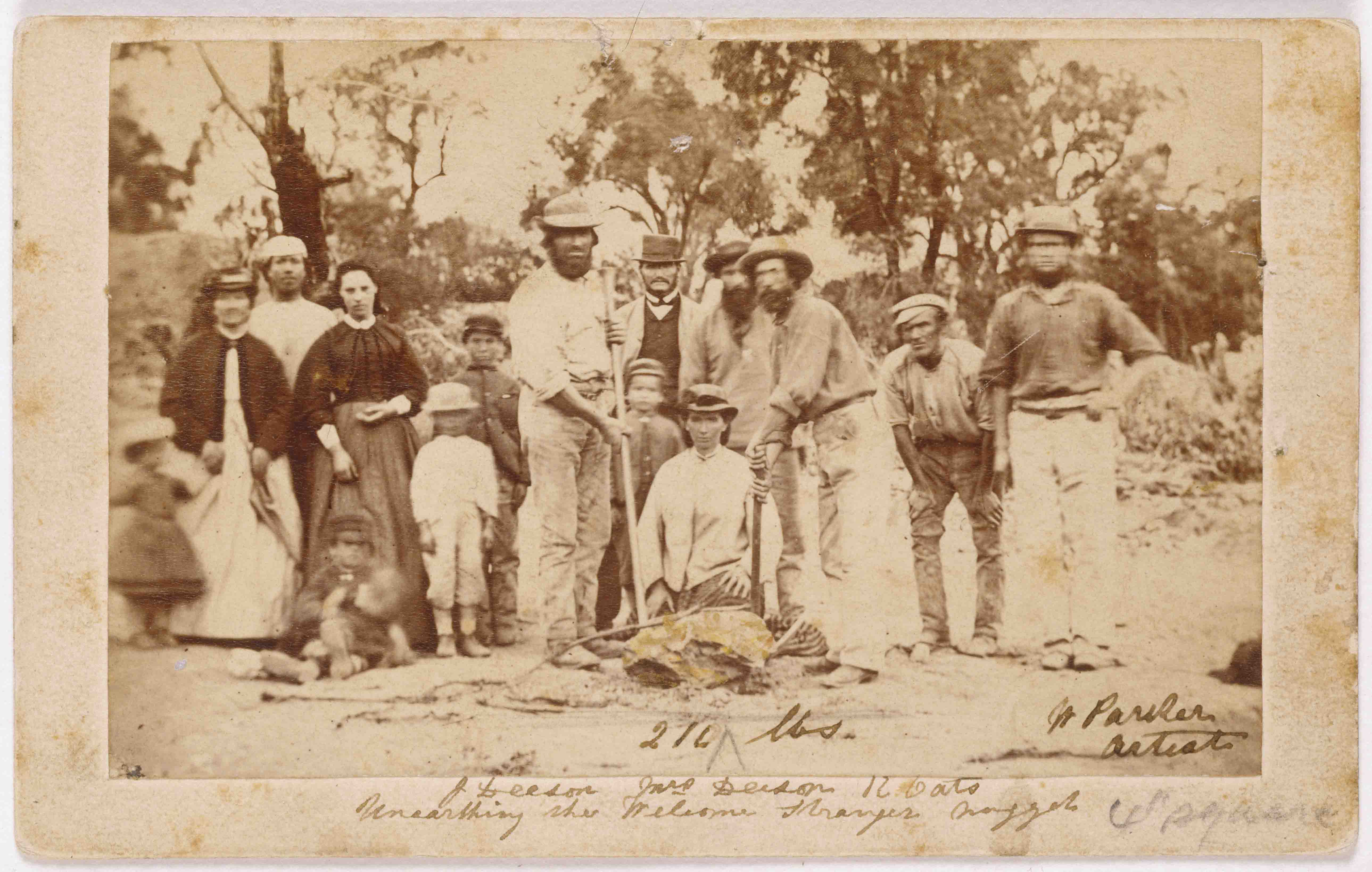
Photograph by W. Parker.
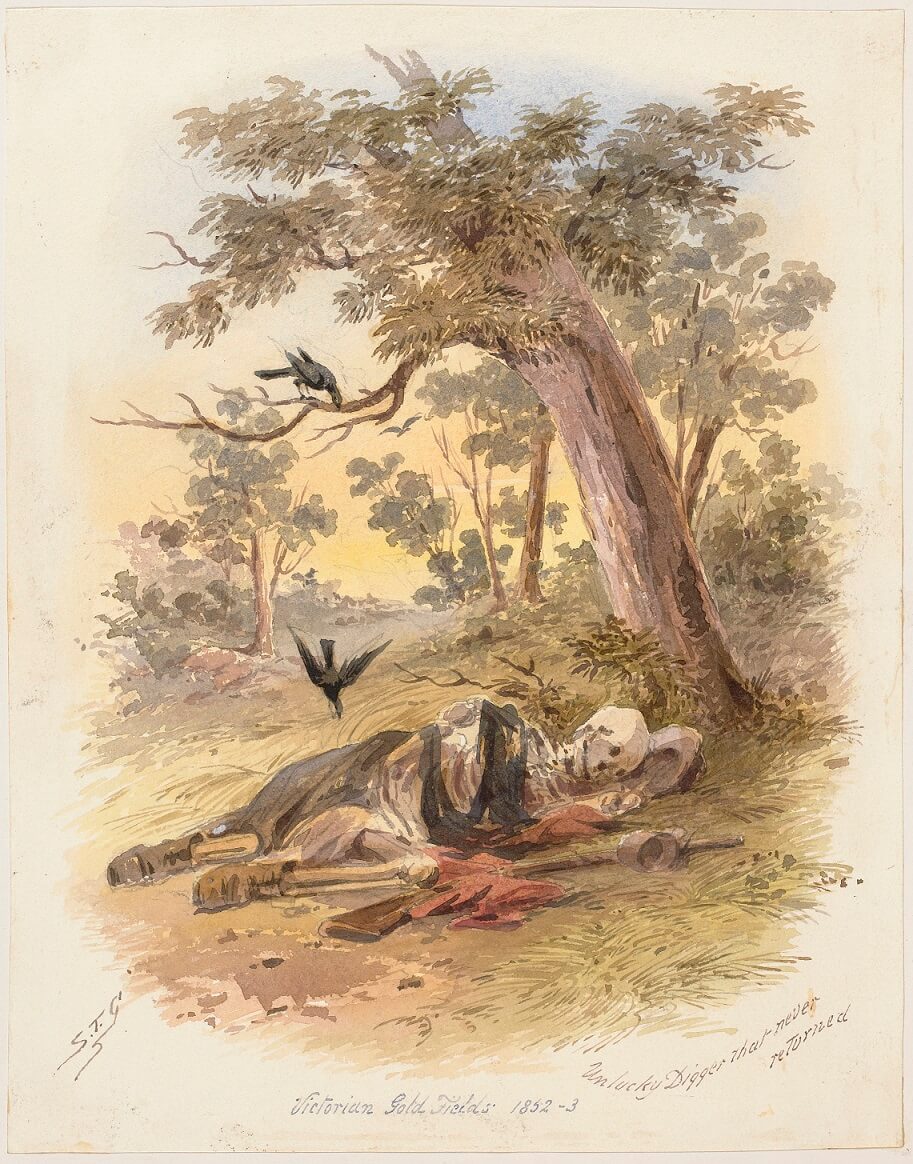
This painting by S.T. Gill shows the skeleton of an unknown digger who died in the bush from starvation or disease and fell prey to scavengers. Other unlucky gold-seekers were seen stumbling in rags along the track back to Melbourne, begging for food or taking whatever menial jobs they could find.
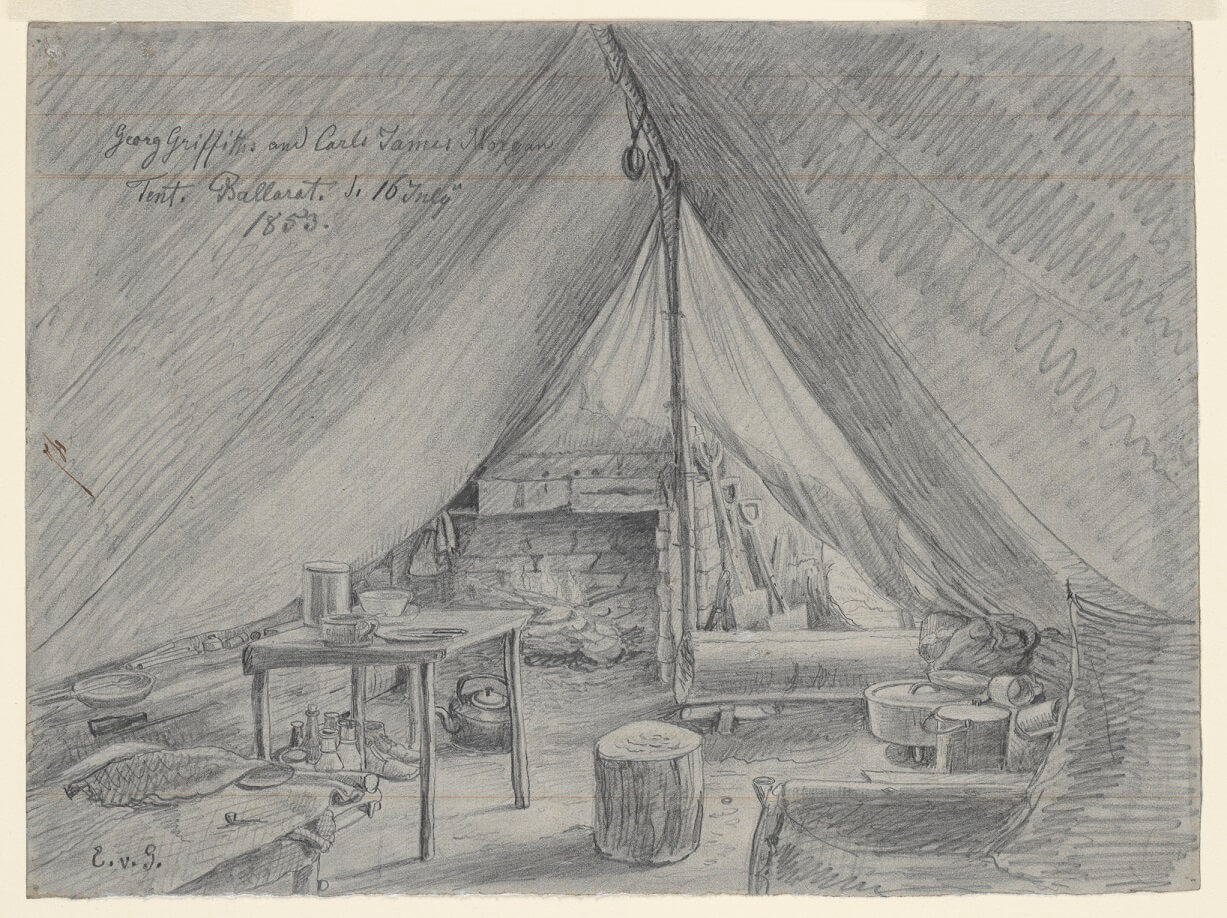
This sketch depicts the primitive nature of goldfields life in the 1850s, although this tent is better equipped than most. There is a fireplace at one end, while a rustic bed, table and log stool serve as furnishings.
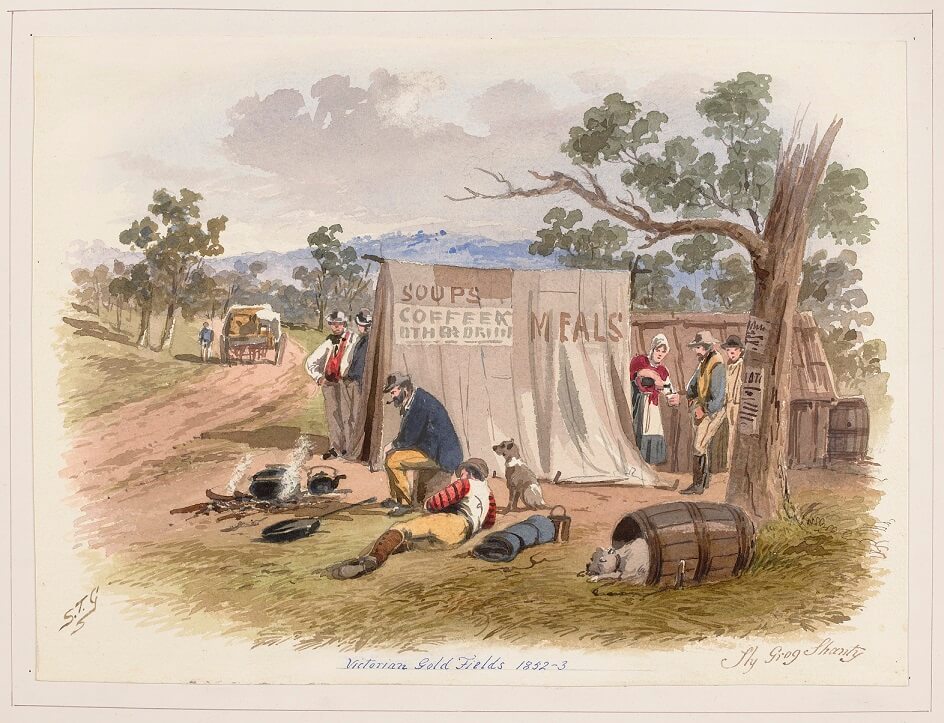
This image shows a way-side tent selling soup and coffee ‘with other drinks’. Sly grog is available at the rear! Sly-grog selling was illegal, but despite the harsh penalties, shops sprang up all over the diggings, posing as stores and soup kitchens. A woman is shown serving the grog – one of several less respectable occupations for women on the goldfields.
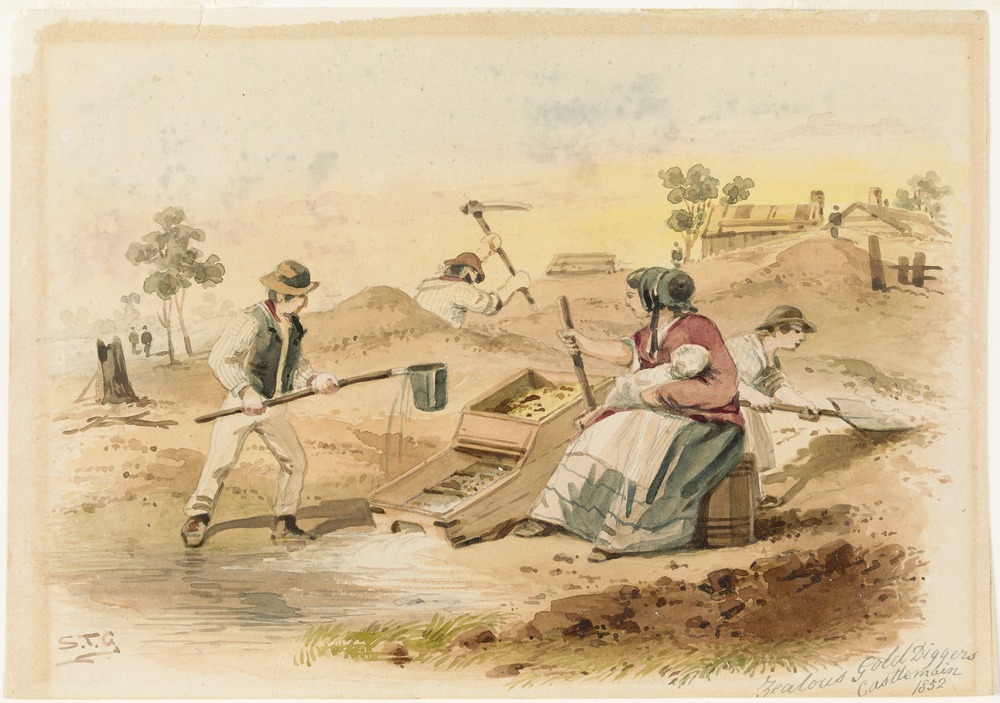
Here Samuel Thomas Gill depicts a family at work. The man pours water into the cradle, the woman rocks it, while nursing a baby. A boy is also working, shovelling dirt. We know that children worked on the goldfields, alongside their parents or in teams with other men. The work was hard for children and could be very dangerous.


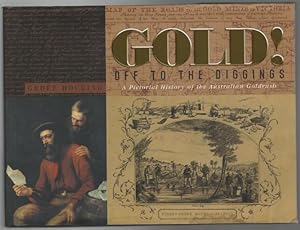 Gold! Off to the diggings : a pictorial history of the Australian gold rush
by
Gold! Off to the diggings : a pictorial history of the Australian gold rush
by
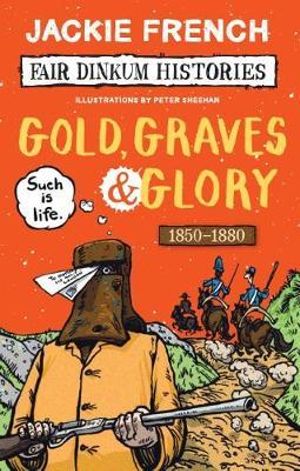 Gold, graves and glory 1850-1880
by
Gold, graves and glory 1850-1880
by
 Gold: a pictorial history of the Australian gold rush
by
Gold: a pictorial history of the Australian gold rush
by
 Gold: the fascinating story of gold in Australia
by
Gold: the fascinating story of gold in Australia
by
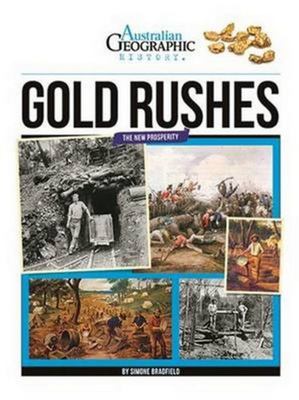 Gold rushes the new prosperity
by
Gold rushes the new prosperity
by
 Life on the goldfields
by
Life on the goldfields
by
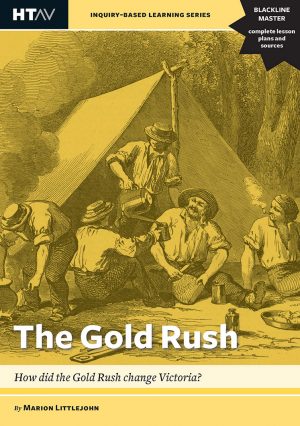 The gold rush : how did the gold rush change Victoria?
by
The gold rush : how did the gold rush change Victoria?
by
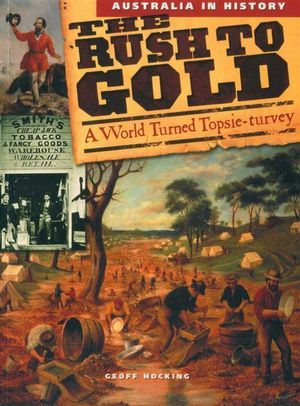 The rush to gold: a world turned topsie-turvey
by
The rush to gold: a world turned topsie-turvey
by